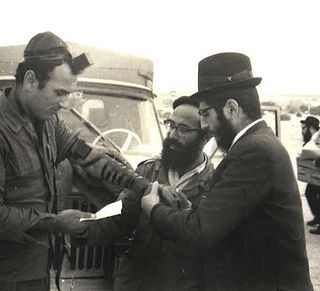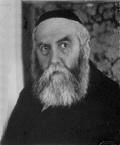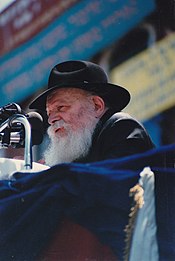
Kislev is the third month of the civil year and the ninth month of the ecclesiastical year on the Hebrew calendar. In the Babylonian calendar its name was Araḫ Kislimu.

Menachem Mendel Schneerson, known to many as the Lubavitcher Rebbe or simply as the Rebbe, was a Russian Empire-born American Orthodox Jewish rabbi, and the most recent rebbe of the Lubavitch Hasidic dynasty. He is considered one of the most influential Jewish leaders of the 20th century.

Chabad, also known as Lubavitch, Habad and Chabad-Lubavitch, is an Orthodox Jewish Hasidic dynasty. Chabad is one of the world's best-known Hasidic movements, particularly for its outreach activities. It is one of the largest Hasidic groups and Jewish religious organizations in the world.

Yosef YitzchakSchneersohn was an Orthodox rabbi and the sixth Rebbe of the Chabad Lubavitch chasidic movement. He is also known as the Frierdiker Rebbe, the Rebbe RaYYaTz, or the Rebbe Rayatz. After many years of fighting to keep Orthodox Judaism alive from within the Soviet Union, he was forced to leave; he continued to conduct the struggle from Latvia, and then Poland, and eventually the United States, where he spent the last ten years of his life.
Dovber Schneuri was the second Rebbe of the Chabad Lubavitch Chasidic movement. Rabbi Dovber was the first Chabad rebbe to live in the town of Lyubavichi, the town for which this Hasidic dynasty is named. He is also known as the Mitteler Rebbe, being the second of the first three generations of Chabad leaders.

Hayom Yom is anthology of Hasidic aphorisms and customs arranged according to the calendar for the Hebrew year of 5703 (1942–43). The work was compiled and arranged by Rabbi Menachem Mendel Schneerson, the seventh Rabbi of Chabad, from the talks and letters of the sixth Chabad Rebbe, Rabbi Yosef Yitzchok Schneersohn. The work was published in 1943.

Chitas is a Hebrew acronym for Chumash, Tehillim (Psalms), and Tanya. These are considered basic Jewish texts according to the Chabad Jewish community, an ultra-orthodox Chasidic group. They have the custom to study these works according to a yearly cycle, which is known colloquially as "doing ChiTaS."

A farbrengen is a Hasidic gathering. This term is only used by Chabad-Lubavitch Hasidim, as other Hasidim have a tish or a botteh. It may consist of explanations of general Torah subjects, with an emphasis on Hasidic philosophy, relating of Hasidic stories, and lively Hasidic melodies, with refreshments being served. It is regarded as a time of great holiness. Farbrengens are public events open to non-Hasidim as well.

Chabad Hasidic outreach is a Kiruv phenomena, whereby Chabad Chasidim attempt to encourage Jews to adopt Orthodox Jewish observance.

Likkutei Sichos, literally, "Collected Talks" contains both the scope and the core of the teachings of the Lubavitcher Rebbe, Rabbi Menachem Mendel Schneerson, and is the most authoritative source-text for Schneerson's way of explaining Judaism and the world writ large.

Maamarim/Ma'amorim in Chabad Hasidism are the central format texts of in-depth mystical investigation in Hasidic thought. In Chabad philosophy, the textual format of the Maamar is used in a great number of published works.

Chabad philosophy comprises the teachings of the leaders of Chabad-Lubavitch, a Hasidic movement. Chabad Hasidic philosophy focuses on religious concepts such as God, the soul, and the meaning of the Jewish commandments.

Chabad customs and holidays are the practices, rituals and holidays performed and celebrated by adherents of the Chabad-Lubavitch Hasidic movement. The customs, or minhagim and prayer services are based on Lurianic kabbalah. The holidays are celebrations of events in Chabad history. General Chabad customs, called minhagim, distinguish the movement from other Hasidic groups.

Toras Chaim is a two-volume work of Hasidic discourses on the books of Genesis and Exodus by the second Chabad Rebbe, Rabbi Dovber Schneuri. The work is arranged in a similar fashion as Likutei Torah/Torah Or, a fundamental work on Chabad philosophy authored by Rabbi Dovber's father, Rabbi Shneur Zalman of Liadi, the founder of the Chabad movement. Both works are arranged according to the weekly Torah portion.
Chaya Mushka Schneersohn was the daughter of Rabbi Dovber Schneuri, the second Rebbe of the Chabad Hasidic movement, and the wife of Rabbi Menachem Mendel Schneersohn the third Rebbe.
Shaina Horenstein was the youngest daughter of Rabbi Yosef Yitzchak Schneersohn, the sixth Rebbe of the Chabad Hasidic movement. In the Chabad community, she is referred to as Rebbitzin Shaina.
Chof Beis Shvat, the 22nd day of the month of Shvat in the Hebrew calendar is the yartzeit of Rebbetzin Chaya Mushka Schneerson, married to the seventh Rebbe of the Chabad Hasidic movement. The day is marked by the Chabad community with public gatherings and other commemorations.

Yud Beis–Yud Gimmel Tammuz, the 12th and 13th days of Tammuz on the Hebrew calendar, are celebrated as a holiday by the Chabad Hasidic community. The holiday commemorates the liberation of Rabbi Yosef Yitzchak Schneersohn, the sixth Chabad Rebbe, from Soviet imprisonment. Schneersohn was born June 21, 1880. The day is marked by public gatherings, additional study and prayer.

Shikun Chabad, also spelled Shikun Habad, is a Hasidic Jewish neighborhood in northern Jerusalem. It includes the oldest Hasidic yeshiva in Israel and Jerusalem, Yeshivas Toras Emes.

Yisroel Jacobson (1895-1975) was a Chabad Hasidic rabbi and the representative of the sixth Chabad Rebbe, Rabbi Yosef Yitzchak Schneersohn, to the United States during the 1920s and 1930s. Rabbi Jacobson was one of the first Lubavitcher activists to arrive in to the United States. He was born in Russia and migrated to the United States in 1925.










